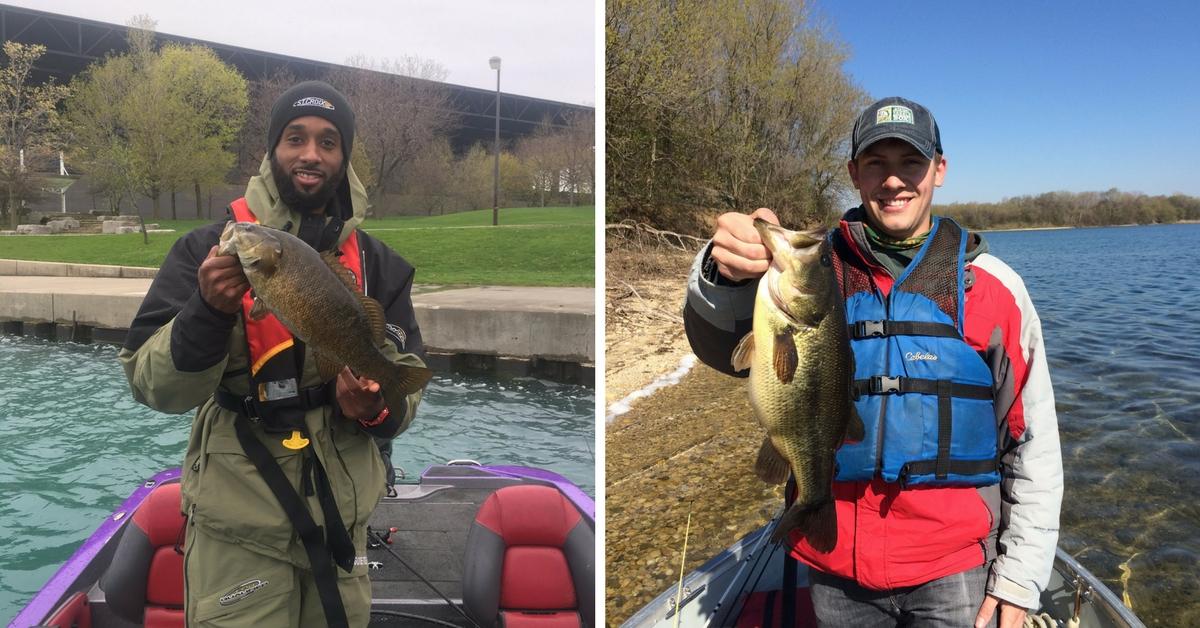Smallmouth Or Largemouth: How To Target Each This Fall
Numerous bass fisheries throughout the nation are multiple choice tests for anglers.The option of fishing for either smallmouth or largemouth bass on rivers or natural lakes has always been available for Northern anglers, but population explosions of smallmouth in reservoirs have turned many bass fisheries throughout the country into multiple choice waters. The two species sometimes share the same habitat and eating habits, but there are times and places in the fall when the action will be better for one species so you will have to choose whether to go for brown or green fish.
What To Use To Catch Smallmouth Or Largemouth Bass
One fall trip we made to Lake Erie typifies how you can catch smallmouth or largemouth on the same fishery by keying on different locations. We started our day fishing the main lake close to the mouth of the Detroit River where we caught more than 30 keeper smallmouth ranging from 2 to 4 pounds. I caught most of my fish drifting a plastic tube like The Big Bite Baits Salt Tube on a 1/4-ounce jighead with the current along a breakline about 14 feet deep. We also caught some of our biggest fish running deep diving crankbaits like the Sebile Action First Bull Crank along the same breakline. In other words, find a breakline and you'll find the fish!When the wind got too strong in the afternoon to fish the main lake we moved into a protected bay and fished a weedline along a flat. Running lipless crankbaits along the weedline produced mainly largemouth bass and a few brown bass.
When Should I Target Smallmouth Or Largemouth Bass?
Weather often dictates which species to target throughout the day. Largemouth are prone to burrow into cover on sunny days so it is easier to pinpoint their strike zone in the thickest part of vegetation or the shade of boat docks. Punching through weed mats with a Texas-rigged soft plastic bait and a weight ranging from 3/4 to 1 1/2 ounces is the best tactic for catching green fish hiding in the vegetation.Calm, sunny weather drives smallmouth to the bottom of humps and rock piles. Dragging a plastic tube attached to a 1/4-ounce jighead or vertical jigging with a drop shot rig triggers strikes from bottom-hugging smallmouth.When it’s windy and rainy both species tend to roam around weed openings and open rocky banks. A variety of tactics, such as burning spinnerbaits, winding swim baits or cranking shad- or crawfish-color crankbaits, will catch both species then. Topwater poppers and walking baits also trick largemouth and smallmouth roaming around on overcast and rainy days.
Does Temperature Affect Smallmouth Or Largemouth?
As the water temperatures continue to cool throughout the fall, both species become more accessible. Largemouth are easy to find during summertime since they set up in cover in bays and creeks, whereas smallmouth tend to scatter out in deep water then. However in autumn both fish migrate to the shallows to feed up for winter.On some Northern lakes, both species tend to bunch up in the same areas such as grasslines. An ideal hangout for both largemouth or smallmouth is an outside grass line mixed with rock. Milfoil rates high as a grass for both species, but hydrilla and coontail is also likely vegetation for finding brown and green bass.While fishing in the fall at either Southern or Midwest reservoirs, both species will move to the shallows. Largemouth will generally hang around wood cover such as log laydowns, stumps and standing timber, whereas smallmouth prefer boulders or transition banks where chunk rock turns to pea gravel. Largemouth can be found as shallow as 1 to 2 feet deep in the fall while smallmouth tend to stay a little deeper (5 to 10 feet).
Water Clarity For Smallmouth Or Largemouth
Water clarity is a determining factor for locating smallmouth and largemouth on a reservoir in the fall. Odds are better for catching smallmouth on the lower, clear section of a reservoir, whereas the chances of catching largemouth are best in the off-color water on the upper end of an impoundment.By late fall, both species move out to ledges and points. Mussel beds on Southern reservoirs are also ideal spots for finding both species during late fall. These fish are usually in a non-aggressive mode so the best lure for this situation is a deep-diving crankbait, a lure capable of deflecting off of the ledge or mussel beds to trigger a reaction strike.A jig-and-plastic craw is hard to beat when both species are hanging around the weed lines in the fall. Combining the jig and craw in pumpkinseed, brown or other natural hues imitates a perch or crawfish to trigger the most strikes from largemouth and smallmouth lurking along the weed edges. Try an All-Terrain Tackle Grassmaster Jig and a Mizmo Bait Company Swamp Monster.Pursuing both species in one day can be fun for the recreational angler, but a tournament competitor has to determine which of the two species will produce a heavier limit. A rule of thumb for targeting these species in tournaments is largemouth generally produce bigger sacks, but smallmouth usually provide more consistent action.
Updated September 28th, 2020 at 8:37 AM CT


